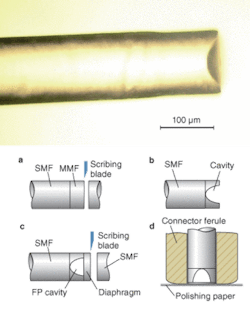Researchers at the University of Maribor (Maribor, Slovenia) have developed a miniature all-silicon dioxide (SiO2) fiberoptic pressure sensor that has pressure sensitivity two orders of magnitude higher than previously reported all-SiO2 sensor designs.1 The finished sensor has a diameter of 125 µm and is composed of a number of single-mode and multimode fiber segments that are fusion-spliced together (see figure).
Sensor construction starts with single-mode optical fiber that is fusion-spliced to a length of multimode fiber with standard 62.5-µm core diameter. The multimode fiber is cleaved approximately 40 µm from the splice joint and then etched in hydrofluoric acid to selectively remove the multimode core material. Etching is stopped when the acid reaches the splice joint, forming a cavity at the end of the fiber. Another section of cleaved single-mode fiber is then spliced to the cavity to be used as a diaphragm. To prevent deformation of the cavity section during the splicing process, the parameters of the fusion-splicer were carefully controlled, with rapid preheating to close the fiber gap, followed by reduced heating. This final section of single-mode fiber is then cleaved 10 to 50 µm from the cavity. The diaphragm and the fiber-cavity interface form a low-finesse Fabry-Perot interferometer: pressure applied to the diaphragm causes deflection, resulting in measurable cavity-length variation.
To precisely control the diaphragm thickness and the pressure sensitivity of the sensor, the end of the fiber device is placed in an optical connector ferrule for polishing. To reduce the thickness of the diaphragm to roughly 4 µm, a 3-µm-grit-size polishing paper is followed by a 0.5-µm-grit-size paper for the last micron. Although polishing ensures high flatness of the fiber endface and minimizes the spatial nonuniformity of the diaphragm thickness required for achieving high sensitivity, the diaphragm still needs to be thinner to provide better pressure sensitivity (at other than very high pressures).
Active monitoring while etching
To fine-tune the diaphragm thickness, controlled wet etching of the sensor tip in buffered hydrofluoric acid (HF) was used. A 4:1 mass ratio of ammonium fluoride (40%)/HF (40%) was used to prevent more rapid etching of the germanium-doped core of the fiber than its SiO2 cladding—preventing the formation of a hole in the center of the diaphragm. The team carefully monitored the etching process by placing the sensor in a pressure vessel and actively monitoring the pressure sensitivity as a function of diaphragm thickness via a laser interrogation system. When the desired sensitivity was achieved, the fiber tip was neutralized and etching was rapidly terminated. Using this method, a repeatable sensor phase change of approximately 0.6 rad per 40-kPa pressure change at 1550 nm was achieved. Attempts to increase sensitivity usually resulted in overetching of the diaphragm.
The sensor interrogation system consists of a tunable laser that transmits a signal through a 2 × 2 coupler to the pressure sensor. The reflected signal passes back through the coupler and is collected by a power meter at the opposite leg from the source. The fourth leg of the coupler is terminated in index-matching gel. This interrogation system shows that the sensor designed for a 0- to 40-kPa pressure range (for biomedical applications) had a sensitivity of approximately 1.1 rad per 40 kPa at 1550 nm, corresponding to a diaphragm deflection of 3.4 nm/kPa (the highest previously reported diaphragm sensitivity for a miniature pressure all-SiO2 sensor was 0.04 nm/kPa).2 The team also fabricated sensors with 0- to 200-kPa and 0- to 1-MPa pressure ranges. For the most sensitive sensor, temperature-induced pressure error was measured to be 53 Pa/K.
“Fiberoptic pressure sensors have been a topic of intense research during the last decade as they can be made very small, compact, immune to electromagnetic interference, biocompatible, and can be used at high temperatures,” says researcher Denis Donlagic. “The high sensitivity achieved by the presented production method can be especially beneficial for biomedical, microfluid mechanics, and other advanced applications.” He notes that the team has applied for a patent and recently entered a partnership with FISO Technologies (Quebec, Canada) to jointly develop this technology into a practical product.
REFERENCES
1. D. Donlagic and E. Cibula, Optics Lett.30(16) 2071 (Aug. 15, 2005).
2. Y. Zhu and A. Wang, IEEE Photon. Technol. Lett.17, 447 (2005).

